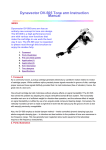Download Beyond Systems Analysis and Design
Transcript
Beyond Systems Analysis
and Design
SYSTEMS ANALYSIS & DESIGN
Introduction
System
Imf=}
to Systems Analysis and Design
n
ementafiGn
nd
Chapter Preview and Ob;ecfives
re about the construction and implementation phases
phases construct, test, install, and deliver the fin
that you understand the processes of constructi
can:
mentation phases of the system's life
I
I
r
'be the system's construction and implementation phases in terms of major tasks,
inputs, and outputs.
I Explain several application program and system tests.
I Identify several system conversion strategies.
I Identify the chapters in this textbook that can help you actually perform the tasks of
systems construction and implementation.
Although some of the techniques of systems construction and implementation are
introduced in this chapter. it is not the intent of this c
r to teach the techniques.
This chapter teaches only the process of construction
implementation.
SYSTEMS ANALYSIS & DESIGN
Systems Construction and Implementation
Chapter Eighteen
569
Introduction
Construction has finally begun on the SoundStage Member Services system. Bob
Martinez is an analyst/programmer, which means that he is expected to do some
programming as well as systems analysis. Tasked with writing code to implement
some of the use cases, Bob is seeing the advantage of all the analysis and design
work that has gone on before. From the repository of design documents, Bob can
draw essentially everything he needs to know to write his programs. His boss, Sandra,
insisted that he write test scripts before he began programming. Again, the use cases
told him what alternatives needed to be tested and what the results should be.
Other members of the systems analysis team are working with database
programmers, application programmers, Web designers and administrators, software
vendors, technical writers, and an outside firm hired to perform systems testing.They
are racing to meet the deadline. But it is gratifying to see the system they designed
becoming a reality.
What Is Systems Construction
and Implementation?
Let's begin with definitions of systems construction and implementation. Systems
construction
is the development, installation, and testing of system components.
Unfortunately, systems development is a common synonym. (We dislike that synonym
since it is more frequently. used to describe the entire life cycle.) Systems implementation is the delivery of that system into production (meaning day-to-day operation).
Figure 18-1 illustrates the construction and implementation phases. Notice that
the trigger for the systems construction phase is the approval of the physical design
specifications resulting from the design phase. Given the design specifications, we can
construct and test system components for that design. Eventually we will have built
the functional system. The functional system can then be implemented or delivered
as an operational system.
This chapter examines each of these phases in detail.
The Construction
Phase
The purpose of the construction phase is to develop and test a functional system that
fulfills business and design requirements and to implement the interfaces between
the new system and existing production systems. Programming is generally recognized as a major aspect of the construction phase. But with the trend toward system
solutions that involve acquiring or purchasing software packages, the implementation
and integration of software components is becoming an equally, if not more, common
and visible aspect of the construction phase,
In this section you will learn about several tasks involved in the construction
phase of a typical systems development project. Figure 18-2 depicts the various
tasks for the construction
phase. Let's examine each construction phase task in
greater detail.
>
Task 6.1 - Build and Test Networks {if Necessary}
Recall that in the requirements analysis phase of systems analysis, we established network requirements. Subsequently, during the design phase we developed distributed
data and process models. Using these technical design specifications to implement
the network architecture for an information system is a prerequisite for the remaining
construction and implementation activities.
systems constnletion
the
development, installation,
and testing of system
components.
systems implementation
the installation and delivery
of the entire system into
production.
BUSINESS COMMUNITY
START:
FINISH:
Problems, Opportunities,
Working
Directives, Constraints,
Business
SYSTEM OWNERS AND USERS
Solution
and Vision
System
2
Improvement
Objectives
PROBLEM
Problem
ANALYSIS
Statement
Statement
Life-Cycle Stage
of Work
3
Scope & Vision
SYSTEM
SCOPE
OPERATION
REQUIREMENTS
DEFINITION
&
MAINTENANCE
-,
Documentation
Post-Audit
Review
Operational
Documentation
System
ANALYSIS
Documentation
1
Business
ReqUirements
Statement
Documentalion
/'
4
<J---
~
Documentation
LOGICAL
DESIGN
r
Functional
System
Documentation
~
5
Documentation
Logical
Design
Redesigned
System
Business
Proposal
DECISION
ANALYSIS
Processes
Design
Prototypes
6
Application
PHYSICAL
DESIGN
Physical
Design Specifications
&
INTEGRATION
Architecture
THE BUSINESS AND
TECHNICAL COMMUNITY
-
-
( approval to continue project _
after deaign phase )
~
~
m
~
»
-,
Vl
I
I
I
Design Specifications
z
»
!<
Vl
Vi
j20
o
m
Vl
Ci
z
Database
Structure
Network
Design
ReqUirements
Functional
System
Network
Details
Revised Database
Schemasand
Test Data Details
Sample
Data
Technical Design
Statement, Plan For
Programming, and
Test Data
Database
Schemas
TECHNOLOGY
Integration
Requirements
& Program
Documentation
INDUSTRY
Software
Packagea
and
Documentation
TECHNOLOGY SALES REPRESENTATIVES
Modilied SIW Specs
& New Integration
Requirements
Program Documentation
New Programs & Reusable Software Components
Reusable Software Components
Software
Package
Introduction to Systems Analysis and Design
572
Part Four
Beyond Systems Analysis and Design
In many cases, new or enhanced applications are built around existing networks.
If so, skip this task. However, if the new application calls for new or modified networks, they must normally be implemented before building and testing databases and
writing or installing computer programs that will use those networks.Thus, the first
task of the construction phase may be to build and test networks.
This phase involves analysts, designers, and builders. A network designer and network administrator assume the primary responsibility for completing this task. The
network designer is a specialist in the design of local and wide area networks and
their connectivity. The network administrator has the expertise for building and testing network technology for the new system. He or she will also be familiar with network architecture standards that must be adhered to for any possible new networking
technology. This person is also responsible for security. (The network designer and
network administrator may be the same person.) While the systems analyst may be in- .
volved in the completion of this task, the analyst's role is more that of a facilitator and
ensures that business requirements are not compromised by the network solution.
>
Task 6.2-Build and Test Databases
Building and testing databases are unfamiliar tasks for many students, who are accustomed to having an instructor provide them with the test databases.This task must immediately precede other programming activities because databases are the resources
shared by the computer programs to be written. If new or modified databases are
required for the new system, we can now build and test those databases.
This task involves systems users, analysts, designers, and builders. The same system specialist that designed the databases will assume the primary responsibility in
completing this task. System users may also be involved in this task by providing or
. approving the test data to be used in the database. When the database to be built is
a noncorporate, applications-oriented
database, the systems analyst often completes
this task. Otherwise, systems analysts mostly ensure business requirements compliance.The database designer will often become the system builder responsible for the
completion of this activity. The task may involve database programmers to build and
populate the initial database and a database administrator to tune the database performance, add security controls, and provide for backup and recovery.
The primary inputs to this task are the database schema(s) specified during
systems design. Sample data from production databases may be loaded into tables
for testing the databases. The final product of this task is an unpopulated database
structure for the new database. The term unpopulated means the database structure
is implemented but data has not been loaded into the database structure. As you'll
soon see, programmers will eventually write programs to populate and maintain those
new databases. Revised database schema and test data details are also produced during this task and placed in the project repository for future reference.
>
Task 6.3-lnstall and Test New Software
Packages (if Necessary)
Some systems solutions may have required the purchase or lease of software packages. If so, once networks and databases for the new system have been built, we can
install and test the new software. This new software will subsequently be placed in
the software library.
This activity typically involves systems analysts, designers, builders, and vendors
and consultants.This is the first task in the life cycle that is specific to the applications
programmer. The systems analyst typically participates in the testing of the software
package by clarifying requirements. Likewise, the system designer may be involved
in this task to clarify integration requirements and program documentation that is to
be used in testing the software. Network administrators may be involved in actually
SYSTEMS ANALYSIS & DESIGN
Systems Construction and Implementation
Chapter Eighteen
573
installing the software package on the network server. Finally, this task typically involves participation from the software vendor and consultants who may assist in the
installation and testing process.
The main input to this task is the new software packages and documentation that
are received from the system vendors. The applications programmer will complete
the installation and testing of the package according to integration requirements and
program documentation developed during system design. The principal deliverable of
this task is the installed and tested software package that is made available in the software library. Any modified software specifications and new integration requirements
that were necessary are documented and made available in the project repository to
provide a history and serve as future reference.
>
Task 6.4-Write and Test New Programs
We are now ready to develop (or complete) any in-house programs for the new system. Recall that prototype programs are frequently constructed in the design phase.
These prototypes are included as part of the technical design specifications for completing systems construction and implementation. However, these prototypes are
rarely fully functional or complete. Therefore, this activity may involve developing or
refining those programs.
This task involves the systems analysts, designers, and builders. The systems analyst typically clarifies business requirements to be implemented by the programs.
The designer may have to clarify the program design, integration requirements, and
program documentation (developed during systems design) that is used in writing
and testing the programs. The system builders will assume the primary responsibility for this activity. The applications programmer (builder) is responsible for writing
and testing in-house software. Most large programming projects require a team effort.
One popular organization strategy is the use of chief programmer teams. The team
is managed by the chief programmer, a highly proficient and experienced programmer who assumes overall responsibility for the program design strategy, standards,
and construction. The chief programmer oversees all coding and testing activities and
helps with the most difficult aspects of the programs. Other team members include
a backup chief programmer, program librarian, programmers, and specialists. The
applications programmer is often aided by an application or software tester who specializes in building and running test scripts that are consistently applied to programs
to test all possible events and responses.
The primary inputs to this activity are the technical design statement, plan for
programming, and test data developed during systems design. Since any new programs or program components may have already been written and be in use by
other existing systems, the experienced applications programmer will know to first
check for possible reusable software components available in the software library.
The principal deliverables of this activity are the new programs and reusable software components that are placed in the software library. This activity also results in
program documentation that may need to be approved by a quality assurance group.
Some information systems shops have a quality assurance group staffed by specialists who review the final program documentation for conformity to standards. This
group will provide appropriate feedback regarding quality recommendations
and
requirements. The final program documentation is then placed in the project repository for future reference.
Testing is an important skill that is often overlooked in academic courses on
computer programming. Testing should not be deferred until after the entire program
has been written! There are three levels of testing to be performed: stub testing, unit
or program testing, and systems testing. Stub testing is testing performed on individual events or modules of a program. In other words, it is the testing of an isolated
subset of a program. Unit or program
testing is testing in which all the events
and modules that have been coded and stub tested for a program are tested as an
stub test a test performed
on a subset of a program.
unit or program test a
test performed on an entire
program.
Introduction to SystemsAnalysisand Design
574
Part Four
systems test a test performedon an entire system.
Beyond Systems Analysis and Design
integrated unit; it is the testing of an entire program. Systems testing ensures that
application programs written and tested in isolation work properly when they are
integrated into the total system. A system test plan should be developed and followed
for testing the system. One or more test scripts are developed for each functional and
nonfunctional requirement.
Just because a single program works properly doesn't mean that it works properly with other programs. The integrated set of programs should be run through a
systems test to make sure one program properly accepts, as input, the output of other
programs. Once the system test is complete and determined to be successful, we can
proceed to the implementation of the system.
The Implementation
Phase
What's left to do? New systems usually represent a departure from the way business
is currently done; therefore, the analyst must provide for a smooth transition from the
old system to the new system and help users cope with normal start-up problems.
Thus, the implementation phase delivers the production system into operation.
The functional system from the construction
phase is the key input to the
implementation phase (see Figure 18-1). The deliverable of the implementation phase
(and the project) is the operational system that will enter the operation and support
stage of the life cycle.
In your information system framework, the implementation phase considers the
same building blocks as does the construction phase (see the chapter home page). In
this section you will learn about several tasks involved in the implementation phase for
a typical systems development project. Figure 18-3 depicts the various tasks for the implementation phase. Let's examine each implementation phase task in greater detail.
> Task 7.1-Conduct
System Test
Now that the software packages and in-house programs have been installed and tested,
we need to conduct a final system test. All software packages, custom-built programs,
and any existing programs that comprise the new system must be tested to ensure
that they all work together.
This task involves analysts, owners, users, and builders. The systems analyst
facilitates the completion of this task. The systems analyst typically communicates
testing problems and issues with the project team members. The system owners and
system users hold the ultimate authority on whether or not a system is operating correctly. System builders, of various specialties, are involved in the systems testing. For
example, applications programmers, database programmers, and networking specialists may need to resolve problems revealed during systems testing.
The primary inputs to this task include the software packages, custom-built programs, and any existing programs comprising the new system. The system test is done
using the system test data that was developed earlier by the systems analyst. As with
previous tests that were performed, the system test may result in required modifications to programs, thus, once again, prompting the return to a construction phase task.
This iteration would continue until a successful system test was experienced.
> Task 7.2 - Prepare Conversion Plan
Once a successful system test has been completed, we can begin preparations to
place the new system into operation. Using the design specifications for the new system, the systems analyst will develop a detailed conversion plan.This plan will identify
databases to be installed, end-user training and documentation that need to be developed, and a strategy for converting from the old system to the new system.
THE BUSINESS AND TECHNICAL
COMMUNITY
SYSTEM OWNERS AND USERS
(OR STEERING COMMITTEE)
l
Software Packages,
custom-aunt Programs, and
any Existing Programs
Operational
Syatem
User Training
Required
Modifications
to Programs
and
Documentation
Successful
Syatem
Teat
System
Test
Data
Design
Spec~ications
Conversion
Plan
Conversion Plan
Appropriate
Documentation
Database
Schema
Restructured
Existing
Data
Existing Data
Database
Structured
FIGURE
Introduction to Systems Analysis and Design
576
Part Four
Beyond Systems Analysis and Design
The project manager facilitates the activity, Systems analyst, system designer, and
system builder roles are not typically involved unless deemed necessary by the project manager, Finally, many organizations require that all project plans be formally presented to a steering body (sometimes called a steering committee) for final approval.
This activity is triggered by the completion of a successful system test, Using
the design specifications for the new system, a detailed conversion plan can be assembled.The principal deliverable of this activity is the conversion plan.
The conversion plan may include one of the following commonly used installation strategies:
• Abrupt cut-over-On
a specific date (usually a date that coincides with an official
business period such as month, quarter, or fiscal year), the old system is terminated and the new system is placed into operation, This is a high-risk approach
because there may still be major problems that won't be uncovered until the
system has been in operation for at' least one business period. On the other hand,
there are no transition costs, Abrupt cut-over may be necessary if, for instance, a
government mandate or business policy becomes effective on a specific date and
the system couldn't be implemented before that date,
• Parallel conversion-Under
this approach, both the old and the new systems
are operated for some time period. This ensures that all major problems in the
new system have been solved before the old system is discarded. The final cutover may be either abrupt (usually at the end of one business period) or gradual,
as portions of the new system are deemed adequate.This strategy minimizes the
risk of major flaws in the new system causing irreparable harm to the business;
however, it also means the cost of running two systems over some period must
be incurred. Because running two editions of the same system on the computer
could place an unreasonable demand on computing resources, this may be possible only if the old system is largely manual.
• Location conversion-When
the same system will be used in numerous geographicallocations, it is usually converted at one location first (using either abrupt or
parallel conversion). As soon as that site has approved the system, it can be farmed
to the other sites. Other sites can be cut over abruptly because major errors have
been fixed. Furthermore, other sites benefit from the learning experiences of the
first test site.The first production test site is often called a beta test site.
• Staged conversion-Like
location conversion, staged conversion is a variation
on the abrupt and parallel conversions. A staged conversion is based on the
version concept introduced earlier, Each successive version of the new system
is converted as it is developed, Each version may be converted using the abrupt,
parallel, or location strategy.
systems acceptance test
a test performed on the
final system wherein users
conduct verification,
validation, and audit tests.
The conversion plan also typically includes a systems acceptance test plan, The systems acceptance test is the final opportunity for end users, management, and information systems operations management to accept or reject the system. A systems
acceptance
test is a final system test performed by end users using real data over an
extended time period, It is an extensive test that addresses three levels of acceptance
testing-verification
testing, validation testing, and audit testing:
• Verification testing runs the system in a simulated environment using simulated
data.This simulated test is sometimes called alpha testing. The simulated test is
primarily looking for errors and omissions regarding end-user and design specifications that were specified in the earlier phases but not fulfilled during construction,
• Validation testing runs the system in a live environment using real data.This is
sometimes called beta testing. During this validation, a number of items are tested:
a. Systems performance.
Is the throughput and response time for processing
adequate to meet a normal processing workload? If not, some programs may
have to be rewritten to improve efficiency, or processing hardware may have
to be replaced or upgraded to handle the additional workload.
SYSTEMS ANALYSIS & DESIGN
Systems Construction and Implementation
Chapter Eighteen
577
b. Peak workload processing performance. Can the system handle the workload during peak processing periods? If not, improved hardware and/or
software may be needed to increase efficiency, or processing may need to be
rescheduled-that
is, consider doing some of the less critical processing during nonpeak periods.
c. Human engineering test. Is the system as easy to learn and use as anticipated? If not, is it adequate? Can enhancements to human engineering be
deferred until after the system has been placed into operation?
d. Methods and procedures test. During conversion, the methods and procedures for the new system will be put to their first real test. Methods and
procedures may have to be modified if they prove to be awkward and
inefficient from the end users' standpoint.
e. Backup and recovery testing. All backup and recovery procedures should
be tested. This should include simulating a data loss disaster and testing the
time required to recover from that disaster. Also, a before-and-after comparison of the data should be performed to ensure that data was properly recovered. It is crucial to test these procedures. Don't wait until the first disaster
to find an error in the recovery procedures.
• Audit testing certifies that the system is free of errors and is ready to be placed
into operation. Not all organizations require an audit. But many firms have an
independent audit or quality assurance staff that must certify a system's acceptability and documentation before that system is placed into final operation.
There are independent companies that perform systems and software certification for end users' organizations.
>
Task 7.3-lnstall
Databases
Recall that in a previous phase you built and tested databases.To place the system into
operation, you will need fully loaded (or "populated") databases. Therefore, the next
task we'll survey is installation of databases. The purpose of this task is to populate the
new system's databases with existing data from the old system.
At first, this activity may seem trivial. But consider the implications of loading a
typical table, say, MEMBER. Tens or hundreds of thousands of records may have to be
loaded. Each must be input, edited, and confirmed before the database table is ready
to be placed into operation.
Systems builders playa primary role in this activity. The task will normally be
completed by application programmers who will write the special programs to extract data from existing databases and programs to populate the new databases. Systems analysts and designers may play a small role in completing this activity. Their
primary involvement will be the calculating of database sizes and estimating of the
time required to perform the installation. Finally, data entry personnel or hired help
may often be assigned to do data entry.
Special programs will have to be written to populate the new databases. Existing
data from the production databases, coupled with the database schema(s) models and
database structures for the new databases, will be used to write computer programs
to populate the new databases with restructured existing data. The principal deliverable of this task is the restructured existing data that has been populated in the databases for the new system.
>
Task 7.4-Train Users
Change may be good, but it's not always easy. Converting to a new system necessitates
that system users be trained and provided with documentation (user manuals) that
guides them through using the new system.
audit test a test performed
to ensure a new system is
ready to be placed into
operation.
Introduction to Systems Analysis and Design
578
Part Four
Beyond Systems Analysis and Design
Training can be performed one on one; however, group training is generally preferred.It is a better use of your time, and it encourages group-learning possibilities.Think
about your education for a moment.You really learn more from your fellow students and
colleagues than from your instructors. Instructors facilitate learning and instruction, but
you master specific skills through practice with large groups where common problems
and issues can be addressed more effectively.Take advantage of the ripple effect of education. The first group of trainees can then train several other groups.
The task is completed by the systems analyst and involves system owners and
users. Given appropriate documentation for the new system, the systems analysts will
provide end-user documentation (typically in the form of manuals) and training for
the system users.The system owners must support this activity. They must be willing
to approve the release time necessary for people to obtain the training needed to become successful users of the new system. Remember, the system is for the user! User
involvement is also important in this activity because the end users will inherit the
successes and failures from this effort. Fortunately, users' involvement during this task
is rarely overlooked. The most important aspect of their involvement is training and
advising the users. They must be trained to use equipment and to follow the procedures required of the new system. But no matter how good the training is, users will
become confused at times. Or perhaps they will find mistakes or limitations. Thus, it
is the responsibility of the analyst to help the users through the learning period until
they become comfortable with the new system.
Given appropriate documentation for the new system, the systems analyst will provide the system users with the documentation and training needed to properly use the
new system.The principal deliverable of this task is user training and documentation.
Many organizations hire special systems analysts who do nothing but write user documentation and training guides. If you have a skill for writing clearly, the demand for your
services is out there! Figure 184 is a typical outline for a training manual. The Golden
Rule should apply to user manual writing:"Write unto others as you would have them
write unto you." You are not a business expert. Don't expect the reader to be a technical
expert. Every possible situation and its proper procedure must be documented.
>Task 7.S-Convert to New System
Conversion to the new system
conversion, the ownership of
programmers to the end users.
out the conversion plan. Recall
from the old system is a significant milestone. After
the system officially transfers from the analysts and
The analyst completes this task by carefully carrying
that the conversion plan includes detailed installation
Training Manual End Users Guide Outline
I. Introduction.
II. Manual.
A. The manual system (a detailed explanation of people's jobs and standard
operating procedures for the new system).
B. The computer system (how it fits into the overall work Row).
1. Terminal/keyboard familiarization.
2. First-time end users.
a. Getting started.
b. lessons.
e. Reference manual (for nonbeginners).
III. Appendixes.
A. Error messages.
\
"~--------------------------
SYSTEMS ANALYSIS & DESIGN
Systems Construction and Implementation
Chapter Eighteen
579
strategies to follow for converting from the existing to the new production information system.This task also involves completing a systems audit.
The task involves the systems owners, users, analysts, designers, and builders. The
project manager who will oversee the conversion process facilitates it. The system
owners provide feedback regarding their experiences with the overall project. They
may also provide feedback regarding the new system that has been placed into operation. The system users will provide valuable feedback pertaining to the actual use
of the new system. They will be the source of the majority of the feedback used to
measure the system's acceptance. The systems analysts, designers, and builders will
assess the feedback received from the system owners and users once the system is
in operation. In many cases, that feedback may stimulate actions to correct identified
shortcomings. Regardless, the feedback will be used to help benchmark new systems
projects down the road.
The key input to this activity is the conversion plan that was created in an earlier
implementation phase task.The principal deliverable is the operational system that is
placed into production in the business.
6.
a. Verification testing tuns the system in a
simulated environment using simulated data.
b. Validation testing runs the system in a live environment using
taoThis is sometimes called
beta tcs'
c. 1'-udit tes
that the system is free of
errors and is ready to be placed into operation.
Introduction to Systems Analysis and Design
1. You are the lead analyst on the system-testing
team of a large enterprise system that will
touch virtually every business function In
the org
tion. Unfortunately, design and
constru
ran behind schedule by about two
weeks. System testing is scheduled to take four
weeks of Intensive effort, assuming no major
problems are found.AddIng resources will not
shorten the time required. If you stay on plan,
implementation will be delayed by two weeks.
The system owner, who is the CEO,finds this
unacceptable and tells you:"What do you mean
that it is going to take a month to system test? I
need this system up in two weeks, not a day later.
If you find any problems, they can be fixed later!"
What do you do in this situation?
2. Consider a variation of the preceding question.
You work as a testing analyst for a software development contractor that has been engaged to
develop this enterprise system. If the project is
not completed on schedule, your company loses a
substantial bonus. Since design and construction
ran behind, you will have to cut system testing in
half.Your company is putting a great deal of implicit pressure on you to compress testing so the
project can finish on schedule and the company
will receive its bonus. You have qualms that if
testing is compressed, some serious problems may
be missed, even with a risk-based testing strategy.
What do you do?
3. You are a systems analyst who will be leading
a systems-testing team on another project.Your
company is adopting a new testing strategy; in the
past, the programmers who constructed the system did the system testing themselves. Why was
this not a good idea?
4. Who should you select for your systems-testing
team? What skills should they have?
5. Are the following statements true or false? Explain
your answer as needed.
a. Building and testing any databases that are
needed should occur after programming
activities are completed.
b. Training of users should be done long before
actual implementation in order to ensure that
everybody receives training without being
rushed.
c. The purpose of parallel conversion is to reduce
business risk.
d. Testing is a highly structured activity that should
not be scheduled to commence until the entire
application program has been written.
e. Systems development and systems construction
are frequently used as synonyms, but they may
not necessarily mean the same thing.
6. As a systems analyst, you have been involved In a
project to develop an inventory-tracklng system
for your business services office.The project is
now coming to its final stages and you have been
asked to write a training manual. Using the outline
shown In Figure 18-4,write a portion of the usual
manual (a page or two) describing the manual
system or the computer system. Have one of your
fellow students or co-workers read and evaluate
for clarity the portion you wrote. Did she or he
SYSTEMS ANALYSIS & DESIGN
Systems Construction and Implementation
tandable and clear? Did it provide
te level of detail that an end user
s construction and implementation,
'vities technical in nature, so
to be involved except for
10.
12.
ad
4. Audit testing
ting completed
system into production environment
D. Unanticipated sudden
shutdown
E.
lication
program-level code
testing
F. Independently
6. Unpopulated
performed certificationdatabase
level testing
G. Module-level testing of
7. Backup and
code
recovery testing
8. Peak performance H. Extensive verification,
validation, and audit
testing
testing
581
I. Environmental-level
testing of application
program(s)
J. Environmental-level
System
testing by users With
implementation
simulated data
Systems
K. Live enviro
acceptance testing
level res
with
L. Tes'
System testing
put/respo
o
M.
tion strategy
Stub testing
type
9. Abrupt cut-off
11.
oduction
out data
in
f throughput/
time under
Chapter Eighteen
13.
9. "The goal of human int
design is to create
a system that is intuitive
e.Th require a users
manual is an admission of failure."Respond to
this statement. Do you agree or
Explain
10. Manyo
. tio
evaluation report
tween six months and a
What purpose(s) does
11. If a project is poorly
and co
will
a well-planned and well-executed imp
tation
effort help the p
cceed? What about
the opposite situatio
a welkiesigned and
weJl.construeted system overcome a poor
implementation effort?
Introduction to Systems Analysis and Design
u able to
lble
6. The
an unwritten principle
no matter how much you plan
implementation, something un
almost always happen, often at
rst possible
moment. Interview several analysts in local
organizations who have expertise in .
systems.Ask them about their
.en
their worst horror story was,
hat
learned from it. Supplement these inte
research on contingency implementaf
Then use your anec
information
to put together a set
idelines on
g
for and handling the unexpected during system
implementation.
1.- Wow Mun
as a Web site, www.wowmuncbies.
com, which is currently hosted on server .
123cooIhost at a Web-hosting company called Cool
Hosting. ButWow Mun
has decided to have
its Web pages updated
rviced by another
hosting company, Reliable Host, using the server
123reliable.The
sting company pointed
the 0
unchies.com to server
123re
it had the Web pages loaded and
tested on its server. It takes 12-72 hours for the
ONS change to take place, and Reliable thought
it would have the Web pages up in the lag time.
It wasn't able to.As a result, the DNSpointed to
the new server for several days before the new
site was functioning again.Wow M
.es lost an
estimated $200,000 in revenues as
fthe
sites downtime. Comment on what went wrong,
and how it could have been avoided.
SYSTEMS ANALYSIS & DESIGN
Systems Construction and Implementation
Mastering Documentation; New York:
JohnWtley
s,1989.
Boehm, Barry. "Software Engineering." IEEE Transactions
on Co
C-25, December 1976. This classic paper
demo
the importance of catching errors and
re programming begins.
Mytbical Man-Montb. Reading, MA:Addison5.
Chapter Eighteen
583
Metzger, Philip w: Managing a Programming Project,
2nd ed. Englewood Cliffs, NJ: Prentice Hall. 1981. This is
one of the few books to place emphasis solely on systems
implementation.
Mosely, D. J. The Handbook of MIS Applicatton Software
Testing. Englewood Cliffs, NJ:Yourdon Press, 1993.
Back Matter





























